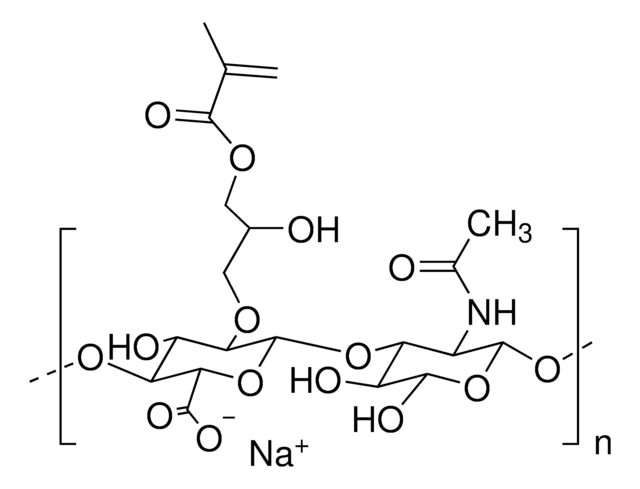917079
PhotoHA™-IRG, methacrylated hyaluronic acid bioink kit, with Irgacure
Synonym(s):
3D Bioprinting, Bioink, HAMA, Hyaluronic acid
Sign Into View Organizational & Contract Pricing
All Photos(1)
About This Item
UNSPSC Code:
12352201
NACRES:
NA.23
Recommended Products
description
Methacrylated hyaluronic acid:
Degree of methacrylation: ≥ 45-65%
Quality Level
sterility
sterile; sterile-filtered
mol wt
Mw 100-150 kDa
composition
Product components :
Methacrylated hyaluronic acid (100 mg)
Irgacure photoinitiator (100 mg)
storage temp.
−20°C
Application
PhotoHA™-IRG bioink kit consists of methacrylated hyaluronic acid (HAMA) and Irgacure photoinitiator. Hyaluronic acid is the most abundant glycosaminoglycan in the body being an important component of several tissues throughout the body. While it is abundant in extracellular matrices, hyaluronic acid also contributes to tissue hydrodynamics, movement and proliferation of cells, and participates in a number of cell surface receptor interactions. The photoinitiator consists of Irgacure 2959 to be formulated in methanol (methanol not included), which allows UV crosslinking of the printed structure at 365 nm. PhotoHA™-IRG provides native-like 3D HA gels, and the final gel stiffness can be customized by changing HA concentrations and crosslinking.
Legal Information
PhotoHA is a trademark of Advanced BioMatrix, Inc.
Hazard Statements
Precautionary Statements
Hazard Classifications
Aquatic Chronic 2
Storage Class Code
11 - Combustible Solids
Choose from one of the most recent versions:
Certificates of Analysis (COA)
Lot/Batch Number
Don't see the Right Version?
If you require a particular version, you can look up a specific certificate by the Lot or Batch number.
Already Own This Product?
Find documentation for the products that you have recently purchased in the Document Library.
Michelle T Poldervaart et al.
PloS one, 12(6), e0177628-e0177628 (2017-06-07)
In bone regenerative medicine there is a need for suitable bone substitutes. Hydrogels have excellent biocompatible and biodegradable characteristics, but their visco-elastic properties limit their applicability, especially with respect to 3D bioprinting. In this study, we modified the naturally occurring
Our team of scientists has experience in all areas of research including Life Science, Material Science, Chemical Synthesis, Chromatography, Analytical and many others.
Contact Technical Service









